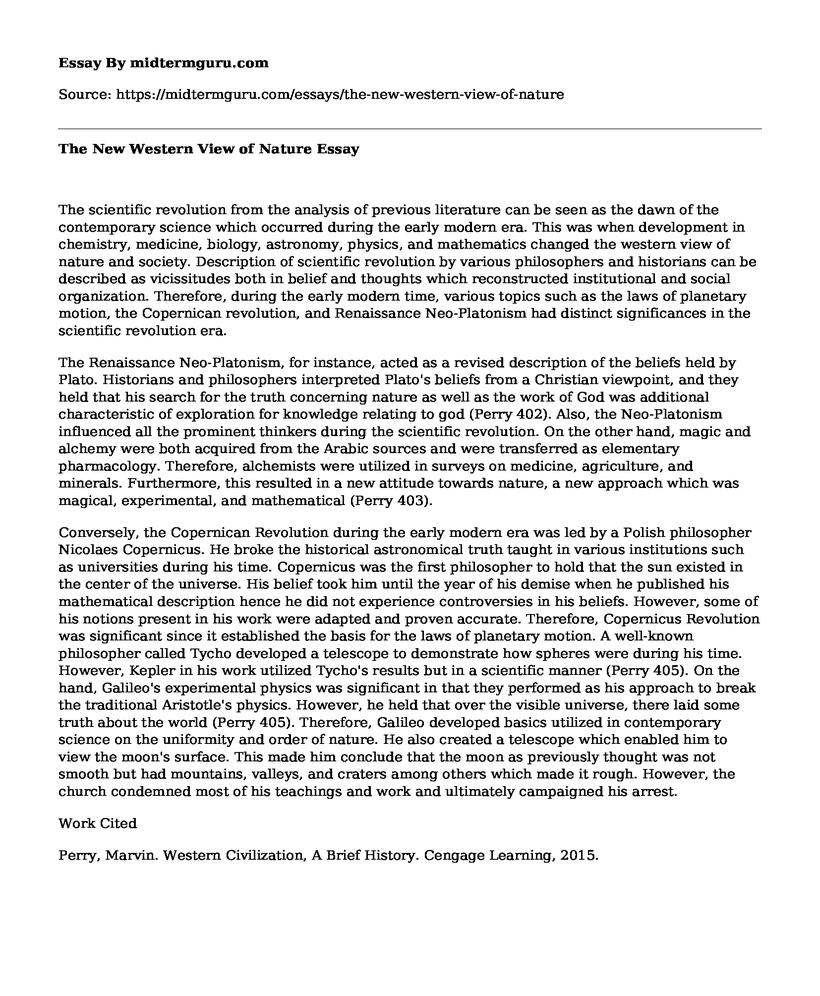The scientific revolution from the analysis of previous literature can be seen as the dawn of the contemporary science which occurred during the early modern era. This was when development in chemistry, medicine, biology, astronomy, physics, and mathematics changed the western view of nature and society. Description of scientific revolution by various philosophers and historians can be described as vicissitudes both in belief and thoughts which reconstructed institutional and social organization. Therefore, during the early modern time, various topics such as the laws of planetary motion, the Copernican revolution, and Renaissance Neo-Platonism had distinct significances in the scientific revolution era.
The Renaissance Neo-Platonism, for instance, acted as a revised description of the beliefs held by Plato. Historians and philosophers interpreted Plato's beliefs from a Christian viewpoint, and they held that his search for the truth concerning nature as well as the work of God was additional characteristic of exploration for knowledge relating to god (Perry 402). Also, the Neo-Platonism influenced all the prominent thinkers during the scientific revolution. On the other hand, magic and alchemy were both acquired from the Arabic sources and were transferred as elementary pharmacology. Therefore, alchemists were utilized in surveys on medicine, agriculture, and minerals. Furthermore, this resulted in a new attitude towards nature, a new approach which was magical, experimental, and mathematical (Perry 403).
Conversely, the Copernican Revolution during the early modern era was led by a Polish philosopher Nicolaes Copernicus. He broke the historical astronomical truth taught in various institutions such as universities during his time. Copernicus was the first philosopher to hold that the sun existed in the center of the universe. His belief took him until the year of his demise when he published his mathematical description hence he did not experience controversies in his beliefs. However, some of his notions present in his work were adapted and proven accurate. Therefore, Copernicus Revolution was significant since it established the basis for the laws of planetary motion. A well-known philosopher called Tycho developed a telescope to demonstrate how spheres were during his time. However, Kepler in his work utilized Tycho's results but in a scientific manner (Perry 405). On the hand, Galileo's experimental physics was significant in that they performed as his approach to break the traditional Aristotle's physics. However, he held that over the visible universe, there laid some truth about the world (Perry 405). Therefore, Galileo developed basics utilized in contemporary science on the uniformity and order of nature. He also created a telescope which enabled him to view the moon's surface. This made him conclude that the moon as previously thought was not smooth but had mountains, valleys, and craters among others which made it rough. However, the church condemned most of his teachings and work and ultimately campaigned his arrest.
Work Cited
Perry, Marvin. Western Civilization, A Brief History. Cengage Learning, 2015.
Cite this page
The New Western View of Nature. (2022, Nov 06). Retrieved from https://midtermguru.com/essays/the-new-western-view-of-nature
If you are the original author of this essay and no longer wish to have it published on the midtermguru.com website, please click below to request its removal:
- My Own Theory of Personality - Essay Sample
- Nurse Manager Skill Inventory - Nursing Paper Example
- Questions and Answers on Communication With Customers - Paper Example
- Deep Brain Stimulation in Parkinson's Disease - Essay Sample
- Research Paper on Intimate Relationship Violence
- Gay Rights Movement: A Revolutionary Change in U.S Society - Essay Sample
- Embrace Diversity for Improved Lifestyles: Why Acceptance Matters - Research Paper







